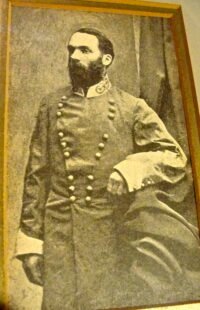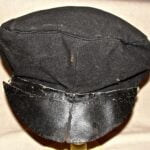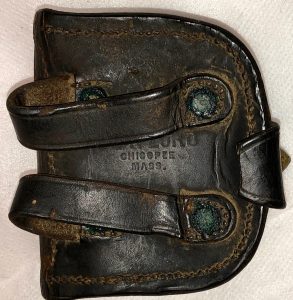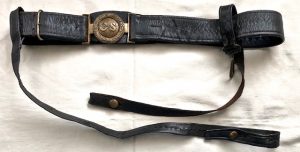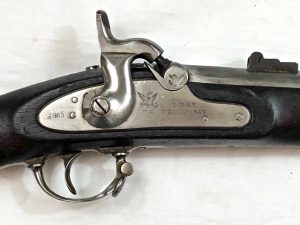Framed Signature of Confederate Gen. Joe Wheeler
SOLD
Framed Signature of Confederate Gen. Joe Wheeler – This clipped signature of Gen. Wheeler has been attractively framed and matted, along with a picture of the General, taken during the Civil War (photo is a modern reproduction of an original image). The signature is on paper and dated 1900; the paper measures as follows: 3.5” x 2.25”; the frame measures: 10.25” x 6.5”.
Joe Wheeler was born near Augusta, Georgia, September 10, 1836, he graduated from West Point in 1859 and was commissioned in Dragoons. He saw service in various Indian campaigns in Kansas and New Mexico before resigning in April, 1861 to become First Lieutenant of Artillery in the Confederate Army.
In September, 1861 he was appointed Colonel of the 19th Alabama Infantry. He commanded a Brigade at Pittsburg Landing (Shiloh), April 6-7, 1862, where he covered the Confederate retreat on the second day, and in July was given command of the Cavalry in General Braxton Bragg’s Army of Mississippi. Thereafter he was almost continuously in the field.
During the remainder of the war he was to be wounded three times and had sixteen horses shot from under him. After leading Bragg’s advance into Kentucky in August-September, distinguishing himself at Perryville, October 8, and covering the retreat from that battle. He was promoted to Brigadier General, CSA, at the end of October. At Stones River (Murfreesboro) from December 31, 1862 to January 3, 1863, he again distinguished himself after having skillfully delayed General William Starke Rosecrans’ advance. In January 1863 he was promoted to Major General.
He took a prominent part in the Battle of Chickamauga, September 18-20, 1863 and, after Rosecrans was shut up in Chattanooga, undertook a spectacular cavalry raid to the Union rear in which he and his men destroyed railroad lines by which Rosecrans was to be re-supplied, and inflicted more that $3 million in damage to support depots and other resources in and around Central Tennessee. In November he cooperated with General James Longstreet in the siege of Knoxville and, following Bragg’s defeat at Lookout Mountain and Missionary Ridge, November 24-25, helped cover the latter’s retreat, taking part under General Patrick R. Cleburne in a rearguard action at Ringgold, November 27.
In 1864, he was active in opposing General William T. Sherman’s advance toward Atlanta, engaging Union cavalry of George Stoneman on several occasions. During Sherman’s March to the Sea, Wheeler fell back slowly in advance of him. He kept a close watch on Federal raiders and foragers on the flanks and thereby confined the destruction to as narrow a front as possible. In February 1865 (aged 28) he was promoted to Lieutenant General. He fought under General Joseph E. Johnston against Sherman in the Carolinas and, after Johnston’s surrender, was captured near Atlanta.
After the war, he entered business in New Orleans; moved in 1868 to Wheeler, Alabama, to practice law and plant cotton. He entered Congress in march 1881, but in June 1882 his seat was successfully contested. His successor soon died and he was elected to the same seat in January 1883 for the last two months of the term. He was again elected to Congress in 1884 and served from March 1885 until his resignation in April 1900. As he rose to the Chairmanship of the Ways and Means Committee, the high rank and personal popularity he had achieved in the Civil War made him something of a symbol of the reunion of the North and South in that period.
At the outbreak of the Spanish-American War in 1898, he offered his services and was appointed a Major General of U.S. Volunteers by President William McKinley in May and was given command of a Cavalry Division (largely unmounted) in William R. Shafter’s V Corps. Troops under his command (including Leonard Wood’s and Theodore Roosevelt’s ‘Rough Riders’) won the Battle of Las Guasimas, June 24, and took part in the assault on San Juan Heights before Santiago de Cuba on July 1, where they formed the U.S. right while Jacob F. Kent’s Infantry Division formed the left. At the conclusion of that campaign, he commanded briefly the convalescent camp at Montauk Point, New York, and also briefly commanded a Brigade in the Philippines, August 1899-January 1900. He was mustered out of the volunteer service and was appointed Brigadier General, United States Army in June 1900. He then commanded the Department of the Lakes until his retirement in September 1900.
He died at his sister’s home in Brooklyn, New York, on January 25, 1906 and was buried in Section 2 of Arlington National Cemetery, one of only two former Confederate generals to be buried in Arlington, the other being Marcus Joseph Wright.
General Wheeler’s son, Joseph Wheeler, Jr., Colonel, United States Army, is buried with him in Arlington National Cemetery.







